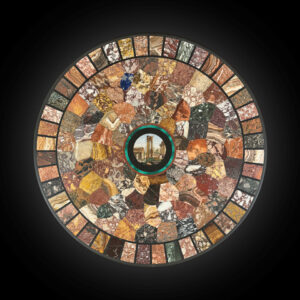
A Regency period Gilt and Ebonised Centre Table with a specimen marble and micro-mosaic top
Reference 1020
English, ca. 1830
An amazing Regency period gilt and ebonised centre table with a specimen marble and micro-mosaic top.
The wonderful top is built up out of a plethora of different marbles and stones all mosaiqüed together and banded by a border made of 44 different marble specimens, including samples of lapis lazuli, red and green porphyry, several types of onyx, jasper, breccia and many others.
In the centre of the top sits a micro-mosaic panel depicting in detail the ruins of the Roman forum bordered by a slate and malachite band.
The top sits on a wonderful anthemion decorated frieze on a fluted column and tripartite base decorated with a greek key finished on scroll feet.
The wonderful base still retains its original decoration.
Depicted within the micro-mosaic from left to right
Displayed on the left
The Arch of Septimius Severus is at the northwestern end of the Roman Forum is a white marble triumphal arch dedicated in 203 AD to commemorate the Parthian victories of Emperor Septimius Severus and his two sons, Caracalla and Geta, in the two campaigns against the Parthians of 194-195 and 197–199.
After the death of Septimius Severus, his sons Caracalla and Geta were initially joint Emperors. Caracalla and Geta were assassinated in Rome, in the practice now known as damnatio memoriae. Geta’s memorials were destroyed and all images or mentions of him were removed from street buildings and monuments. Accordingly, Geta’s image and inscriptions referring to him were removed from the arch.
Displayed in the centre
The Temple of Castor and Pollux is an ancient temple. It was originally built in gratitude for victory at the Battle of Lake Regillus(495 BC). Castor and Pollux (Greek Polydeuces) were the Dioscuri, the “twins” of Gemini, the twin sons of Zeus (Jupiter) and Leda. Their cult came to Rome from Greece via Magna Graecia and the Greek culture of Southern Italy.
Displayed on the right
The Temple of Jupiter Optimus Maximus, Temple of Jupiter, the Best and Greatest’), was the most important temple in Ancient Rome, located on the Capitoline Hill. It was surrounded by the Area Capitolina, a precinct where numerous shrines, altars, statues and victory trophies were displayed.
Dimensions
Width 84 cm (33″)
Height 77 cm (30 1/4”)
SOLD
+ 44 (0) 7880 620 291



